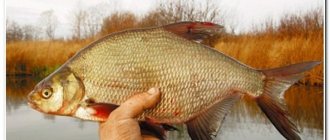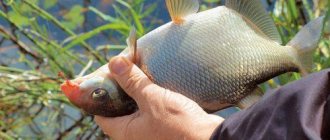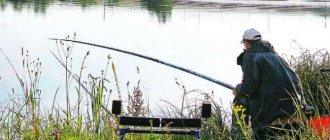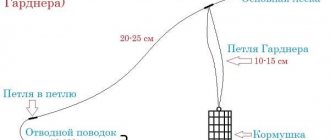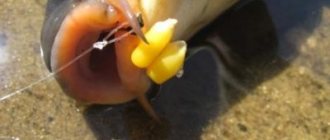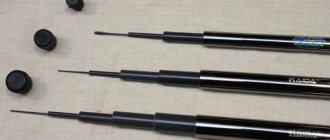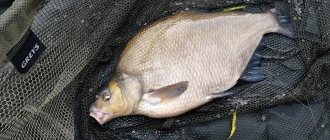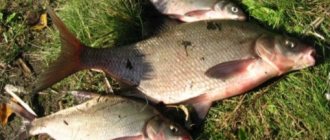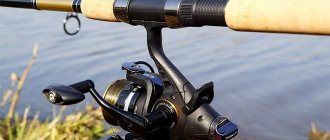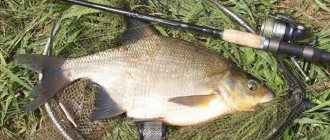At the end of May, bream finishes spawning. Its active biting can be observed already two weeks after spawning and the bream biting continues until the third decade. During this period, the bream begins to really eat, and there is an excellent opportunity to catch a lot of valuable fish.
We recommend reading the article about fishing with a ring. It is at the beginning of summer - in June, that the bream switches to a changed diet. A small bream can eat almost everything it finds on the bottom, while an adult bream will choose the most high-calorie food.
Where to look for bream in summer?
In June, when the water is already quite warm, bream, like many other fish, rushes to cooler places in the depths. At this time, it is worth catching bream on a feeder on shallows that stretch away from the shore and turn into holes. In rivers, you should look for bream in creeks and pools, in places with moderate currents and along steep clay banks.
In the shallows, bream feed on worms and caddis. In shallow lakes, bream lives in thickets of water lilies or on the borders of reeds and reeds. The bream here feeds on various larvae, insects that live directly on these underwater plants.
It can enter the thicket either at night or early in the morning, or even stay there during the day. The right fishing location contributes to success. When choosing a place, they are guided by the fact that in June bream moves between the coastal vegetation and the riverbed, so it is caught near the shore or at depth.
An experienced fisherman can easily determine the habitat of bream by the “game” and by bubbles, but there are cases when promising places for bream are located at a great distance from the shore, which simply does not allow visual exploration of the place. In such cases, examining the bottom with a marker and using a feeder gives good results. Also, when catching bream on a feeder, experienced fishermen pay attention to the weather.
Feeder gear for catching bream in June
All feeder tackle should be light, but at the same time practical. A light and durable feeder rod is used, equipped with a spinning reel with a gear ratio of 4:1 to 5:1 with a reel size of approximately 2000 to 4000 according to the Shiman classification. If fishing is carried out in a fast current and from a bottom strewn with large stones, then you need to use a reel for high-speed reeling (with a gear ratio of at least 6:1). The diameter of the spool is selected depending on the diameter of the fishing line. It would not be superfluous to have a baitrunner on the reel.
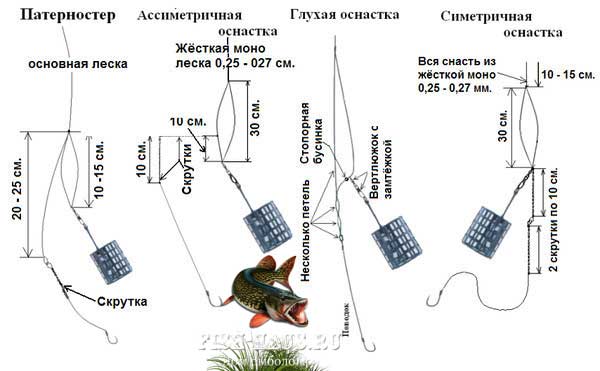
A typical feeder rod has three brightly colored interchangeable tips of varying stiffness. The softest tip is designed for fishing in weak currents, the middle one is for fishing in medium currents, and the hard tip is designed for fishing in fast currents. There are rods that come with more tips. Then it is easier to select a bite alarm for the water stream chosen for fishing.
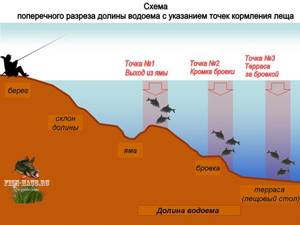
For river fishing, choose a feeder blank with a length of 2.5 to 3.5 m. In some cases, longer rods are used, but then for casting you should choose a bank free from vegetation. However, sometimes a long rod also helps when fishing on a heavily overgrown bank if you use a pendulum cast.
Mono-line is not very thick, no more than 0.25 mm, so as not to scare off sensitive fish. But you shouldn’t choose too thin a fishing line, because bream can reach large sizes. Braided fishing line is also perfect; you can choose it with a smaller diameter, from 0.08 mm, depending on the quality of the fishing line.
You should also not forget about the shock leader for the feeder.
When fishing for bream on a feeder in June on a river with a current, the optimal bream leader will be 40-70 cm. In other cases:
- The bites are weak, the fish swallows the bait deeply: shorten the leash in increments of 5-15 cm. Set it to 30-40 cm.
- The bites are rare, small breams are biting - we try to lengthen the leash to 1-1.5 meters. This is of course not from 30 cm to 1.5 meters immediately. We also add 10-20 cm in increments.
The current plays into the hands of the feeder who uses long leashes, because it pulls the leash into a line, which allows you not to lose the sensitivity of the bite when using an asymmetrical, symmetrical loop and paternoster. It is important to knit loops and knots correctly. So for the Gradner paternoster, the surgical loop is made with at least three turns. A description of various feeder installations is presented here, with the correct selection depending on the current, type of reservoir and soil.
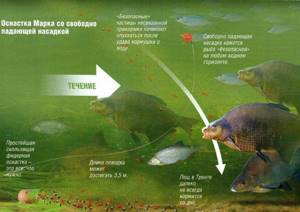
The length of the leash for a feeder for bream in still water - a lake - is 40-80. This length is due to the absence of noise due to the current at the bottom of the reservoir and, accordingly, the bream’s mood for short leashes. But it also happens like this:
- The bites are weak, rare, the fish lands on its own, there are frequent overlaps and tangling of the leash; we set the length to 10-20 cm less. The windage of the leash during immersion is reduced and the leash lies in an arc, next to the feeder.
- If there is no bite at all when catching bream on the feeder, we set the leash to the maximum possible length - up to 1.5 meters
There are still many different variations of complementary foods, baits, gear and rules for catching bream. But fish also have different preferences, which are not always immediately clear, and with experience, the fisherman gets better and better at doing this.
The influence of weather on bream biting
The bream bite is stable at constant atmospheric pressure. It is well fished in warm, cloudy, calm weather, and even during rain. Northern and eastern winds bring bad weather, which makes the bream bite worse. When it gets colder, the bream bite weakens or may stop altogether.
At the beginning of summer, when bream bites intensively, it is better to catch it either early in the morning or in the evening. Throughout the hot day in early summer, bream can be found in holes, depressions and on edges. In the evening it goes out onto shallow slopes to feed, and when darkness falls it moves to areas overgrown with vegetation. At the beginning of summer, bream can be caught well on feeder tackle using maggots, worms and steamed peas.
As bait for bream you can use: thick semolina porridge, shell meat, boiled potatoes and steamed wheat. The correct selection of nozzles in the summer is of great importance.
Catching bream on a feeder
So, after you have chosen a promising place for fishing and laid out all the necessary gear, you should start preparing bait. The bait for bream on the feeder should be aromatic, tasty and, most importantly, there should be a lot of it.
Bream loves to eat, and in order to lure it to the fishing spot, and most importantly, keep it, the bait must be of high quality. It should contain a minimum amount of large particles that could quickly saturate the bream.
It is best to make fine-grained bait, or even better, sift it through a sieve. You can make feeder bait for bream yourself, or you can save time and simply buy it at a fishing store. Fortunately, there are a lot of bream feeder baits, and the choice of flavors is practically unlimited.
In the summer, using feeder equipment, it is worth trying bait with the smell of garlic, strawberries and even plums. When mixing feeder bait, add water in small portions so as not to over-wet it. The bait for bream should stay well in the feeder, reach the bottom, and quickly wash out from there, thereby creating a feeding path and a feeding spot.
Feeder on the pond
Often when feeder fishing I feed the place compactly, but the bulk of the crucian bites come a little to the side. And it seems logical in the future to feed exactly the point where it bites. But no matter how much I tried, it only got worse; in some cases, the crucian carp disappeared altogether. So, if the crucian carp bite is not where the bait is, but 2-5 m to the side, I still feed the original place, and only then move it to where there are bites, but I no longer fill the feeder with food.
When there is no bite at all for a long time, but the fish shows its presence for some reason, I begin to very slowly and smoothly pull up the feeder. I pulled it up literally 3-5 cm, pause for 2-3 seconds, pulled it up again, again a short stop. It happens that the fish responds well to fairly fast and long pull-ups, but more often it’s the slow, short ones that work, and that’s how I start teasing crucian carp and other fish. “Slowly” is a very vague concept, but often it is necessary to pull the equipment as slowly as possible, evenly, which cannot be achieved with either a rod or a reel if you rotate the handle directly, especially in faster reels. Therefore, I turn not the handle, but the rotor itself with my finger, achieving the minimum speed and smoothness of this movement. By the way, only slow, short pull-ups allow you to not move the baited hook too far from the bait spot.
When stretching, the option works very well when the hook with the nozzle is 3-5 cm from the bottom. If I fish with a float tackle, then to do this I’ll just slightly reduce the working descent. On the feeder, I use a hook with an elongated shank, on which I first put a foam ball of the required carrying capacity, only then the bait, and on a leash 3-5 cm from the hook I place a lead shot, which limits the distance the bait can float up.
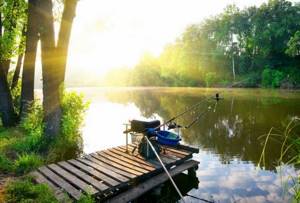
Clipping the fishing line
Feeders for feeder fishing should be selected with a large capacity in order to constantly keep the insatiable bream at the fishing point. The weight of the load should be selected as low as possible so that the feeder does not weigh down in silt and is not carried away by the current. As a feeder rig for catching bream in the summer, a Gardner loop, a symmetrical, asymmetrical loop and a rig with a tube are suitable.
The length of the leash should be from 30 to 100 centimeters. If the bream bites very carefully, it is worth lengthening the leash, this will allow the bream to swallow the bait deeper and the probability of hooking will be higher.
You should select very small hooks, because in combination with a thin long leader, a light hook will play well on the bottom, thereby attracting bream with its natural presentation. It is worth putting a combination of dung worms, bloodworms and maggots on the hooks.
Hooking a bream should be done smoothly so as not to tear its lips. Fishing should be done slowly and carefully, using the feeder rod and the friction brake of the reel.
For more useful information about feeder fishing, see our section here.
Green feeder
It happens that when fishing with a feeder you miss the viscosity of the river bait, and it gets washed out of the feeder too quickly. As luck would have it, you don’t find anything binding at hand, you can’t even find normal clay. Then I use ordinary meadow grass or algae, finely cutting them, mixing them with insufficiently viscous complementary food, and it stays much better in the feeder. While doing similar experiments, I noticed that the greenery itself attracts fish, especially in the June heat. And he began to use algae more often, pondweeds that are familiar and loved by fish, urut, calamus, and mulberry, trying to choose fresh ones, even on old shoots. I started trying to fish even without bait, mixing finely chopped algae with clay, filling the feeder - this food works great in the summer heat, having its own powerful natural aroma, so I don’t add any additional flavoring.
Usually, with this type of feeding, bloodworms work best for me as bait on the hook. True, various little things are constantly encroaching on him, interfering with fishing. Then I increase the size of the hook, insert a dung worm into two punctures, and only then a few bloodworms - the little things bother me much less.
